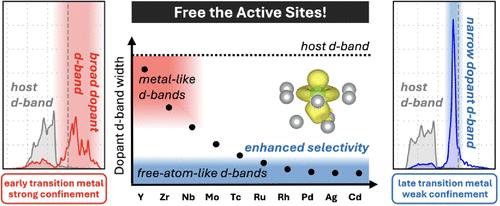When Are Dopant d-States Free-Atom-Like? Periodic Trends and Confinement Effects in Single-Atom Alloys
IF 15.6
1区 化学
Q1 CHEMISTRY, MULTIDISCIPLINARY
引用次数: 0
Abstract
The free-atom-like character of dopant d-states is a defining feature of single-atom alloys (SAAs), contributing to their exceptional selectivity and activity in heterogeneous catalysis. Based on reliable density functional theory (DFT) calculations for the full series of 4d transition metal (TM) dopants embedded in various hosts, we provide a unified perspective on when dopants exhibit this characteristic and how it can be tuned. Only late TM dopants exhibit the narrow, free-atom-like d-bands typically associated with SAAs, whereas early TM dopants display significantly broader d-bands that approach the width of host metal d-bands. This variation is not driven by increased dopant–host d-state mixing, which remains minimal across the series. Instead, we attribute the observed periodic trend to differences in the spatial extent of the localized dopant states and their overlap with surrounding host atoms, as well as to avoided hybridization associated with d-state filling. We further corroborate that dopant confinement, quantified by the number and proximity of surrounding host atoms, is as a key factor: more confined dopants exhibit broader d-bands, whereas less confined dopants feature narrower d-bands. Reduced dopant confinement also stabilizes high-spin configurations, enhancing spin polarization for certain 4d elements. Together, these findings offer fundamental insights into the origins of the unique electronic structure of SAAs. Building on these findings, we establish design principles for tuning dopant d-band shape and spin and illustrate how such modifications impact catalytic selectivity. The developed guidelines are also encapsulated in a machine learning model that predicts d-band widths, facilitating the rational design of SAAs.

什么时候掺杂d态是自由原子样的?单原子合金的周期趋势和约束效应
掺杂d态的自由原子特征是单原子合金(SAAs)的一个决定性特征,有助于它们在多相催化中具有出色的选择性和活性。基于可靠的密度泛函理论(DFT)计算全系列的四维过渡金属(TM)掺杂剂嵌入在不同的宿主,我们提供了一个统一的观点,当掺杂剂表现出这种特性,以及如何调整它。只有晚期TM掺杂剂表现出与SAAs相关的窄的、自由原子样的d带,而早期TM掺杂剂表现出明显更宽的d带,接近宿主金属d带的宽度。这种变化不是由增加的掺杂-宿主d态混合驱动的,这在整个系列中仍然是最小的。相反,我们将观察到的周期性趋势归因于局域掺杂态的空间范围差异及其与周围宿主原子的重叠,以及避免与d态填充相关的杂化。我们进一步证实,掺杂剂的约束(通过周围宿主原子的数量和接近程度来量化)是一个关键因素:更受限的掺杂剂表现出更宽的d带,而更少受限的掺杂剂则表现出更窄的d带。减少掺杂约束也稳定了高自旋构型,增强了某些四维元素的自旋极化。总之,这些发现为SAAs独特的电子结构的起源提供了基本的见解。在这些发现的基础上,我们建立了调整掺杂d带形状和自旋的设计原则,并说明了这种修饰如何影响催化选择性。开发的指导方针还封装在预测d波段宽度的机器学习模型中,促进了SAAs的合理设计。
本文章由计算机程序翻译,如有差异,请以英文原文为准。
求助全文
约1分钟内获得全文
求助全文
来源期刊
CiteScore
24.40
自引率
6.00%
发文量
2398
审稿时长
1.6 months
期刊介绍:
The flagship journal of the American Chemical Society, known as the Journal of the American Chemical Society (JACS), has been a prestigious publication since its establishment in 1879. It holds a preeminent position in the field of chemistry and related interdisciplinary sciences. JACS is committed to disseminating cutting-edge research papers, covering a wide range of topics, and encompasses approximately 19,000 pages of Articles, Communications, and Perspectives annually. With a weekly publication frequency, JACS plays a vital role in advancing the field of chemistry by providing essential research.

 求助内容:
求助内容: 应助结果提醒方式:
应助结果提醒方式:


